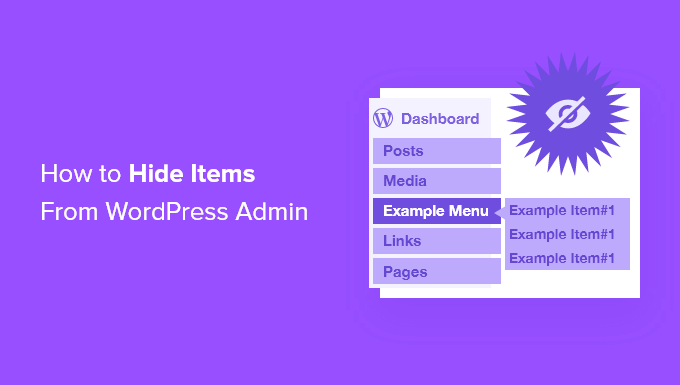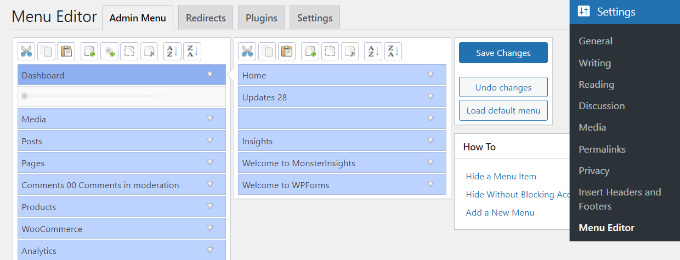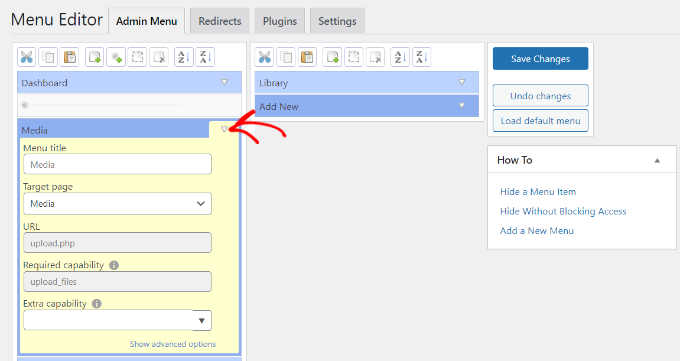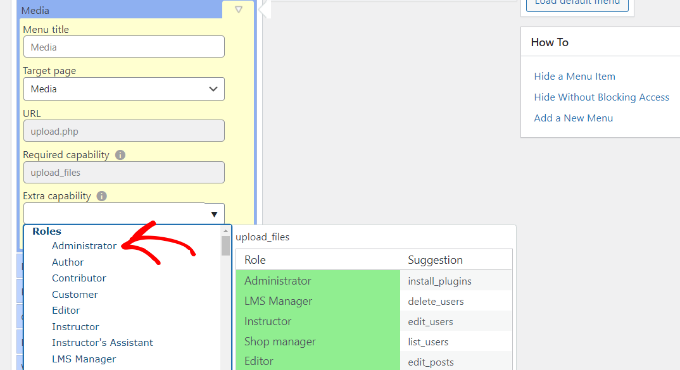Você já se perguntou se é possível limpar a área de administração do WordPress para você e seus usuários?
Há muitas coisas na área de administração do WordPress (wp-admin) que seus usuários, autores ou clientes não precisam ver ou usar. Limpar a área de administração ajuda a mantê-los concentrados apenas nas opções de que precisam, sem distrações.
Neste artigo, mostraremos a você como ocultar itens desnecessários do administrador do WordPress.

Por que ocultar itens do menu de administração no WordPress?
Na área de administração do WordPress, há vários menus, submenus, opções e configurações de temas e plugins que você pode alterar a qualquer momento. Alguns desses itens do menu de administração do WordPress incluem widgets do painel, área de edição de posts, plugins, aparência, ferramentas e muito mais.
No entanto, a maioria dessas opções de menu não é usada diariamente e acaba sobrecarregando a tela de administração. Se você administra um site WordPress com vários autores ou tem clientes visitando a área de administração, é uma boa prática limpar o painel de administração do WordPress.
Você deve manter apenas os menus e as opções que são úteis para seus autores e clientes e ocultar o restante dos submenus.
Você também pode querer desativar itens com base nas funções do usuário, criando diferentes interfaces de administração para usuários com diferentes funções e recursos no seu site WordPress.
Dito isso, vamos ver como você pode remover itens de menu desnecessários do administrador do WordPress.
Observação: este guia é sobre o menu de administração de back-end que um usuário registrado no seu site vê quando faz login.
Se você quiser personalizar os menus de navegação que todos os visitantes do seu site veem, consulte nosso guia passo a passo sobre como adicionar um menu de navegação no WordPress.
Tutorial em vídeo
Se você preferir instruções por escrito, continue lendo.
Como ocultar itens específicos do menu de administração do WordPress
A maneira mais fácil para iniciantes de ocultar menus e itens do painel de administração do WordPress é usar o plug-in Admin Menu Editor. É um plug-in gratuito do WordPress que permite alterar os títulos dos menus, URLs, ícones e muito mais.
Você também pode ocultar itens de menu da barra lateral de administração, definir permissões de função de usuário e arrastar e soltar itens de menu para organizar a barra de administração do WordPress.
Primeiro, você precisará instalar e ativar o plug-in Admin Menu Editor. Para obter mais detalhes, consulte nosso guia sobre como instalar um plug-in do WordPress.
Após a ativação, você pode ir para Configurações ” Menu Editor no painel do WordPress. Nessa página de configurações, você verá todos os seus itens de menu e submenu na guia “Admin Menu”.

Você pode simplesmente arrastar e soltar os itens do menu para reorganizar a ordem deles. Há também opções para remover ou adicionar novos itens de menu.
Em seguida, clique na seta para baixo de qualquer item de menu para ver mais opções. Você pode renomear o título do menu, alterar a página de destino e muito mais.

Para ocultar um item do menu do administrador para um usuário específico, basta clicar no menu suspenso “Extra capability” (Recurso extra). Depois disso, você pode escolher a função do usuário que pode visualizar o item de menu nas opções fornecidas.
Por exemplo, digamos que você queira ocultar o menu Mídia e seus submenus para todas as funções de usuário, exceto a de administrador. Para fazer isso, basta clicar no menu suspenso “Extra capability” (Recurso extra) e escolher “Administrator” (Administrador) em Roles (Funções).

Quando terminar, vá em frente e salve suas alterações.
Agora, o item de menu Mídia estará visível apenas para a função Administrador e ficará oculto para outras funções de usuário.
Se alguém ainda tentar acessar o item de menu oculto digitando o URL, verá a mensagem de erro: “Você não tem permissões suficientes para acessar esta página de administração”.

Agora você pode repetir essas etapas para ocultar outros itens do menu de administração e plug-ins para diferentes usuários.
Para obter mais maneiras de personalizar o administrador do WordPress, consulte estes guias:
- Dicas vitais para proteger sua área de administração do WordPress (atualizado)
- Como colocar um rótulo branco em seu painel de administração do WordPress
- Como adicionar avisos de administração personalizados no WordPress
- Como proteger seu diretório de administração do WordPress (wp-admin) com senha
- Como alterar o esquema de cores do administrador no WordPress (rápido e fácil)
Esperamos que este artigo tenha ajudado você a ocultar itens desnecessários da área de administração do WordPress. Talvez você também queira conferir nosso tutorial completo do WordPress sobre otimização de mecanismos de pesquisa (SEO) e os melhores plug-ins do WooCommerce.
Se você gostou deste artigo, inscreva-se em nosso canal do YouTube para receber tutoriais em vídeo sobre o WordPress. Você também pode nos encontrar no Twitter e no Facebook.





Syed Balkhi says
Hey WPBeginner readers,
Did you know you can win exciting prizes by commenting on WPBeginner?
Every month, our top blog commenters will win HUGE rewards, including premium WordPress plugin licenses and cash prizes.
You can get more details about the contest from here.
Start sharing your thoughts below to stand a chance to win!
Jiří Vaněk says
I have been using the website every day for about a year and a half. During that time, I have already installed almost everything I need for my work, but the truth is that it now has twice as many items and practically I need maybe half of it. Is it necessary to install a plugin, or can some parts of the menu be hidden with a snippet? He would like to avoid another plugin.
WPBeginner Support says
The code required in a snippet would be a bit beyond what we would recommend for beginners which is why we recommend the plugin. For concerns about using a plugin we would recommend taking a look at our article below:
https://www.wpbeginner.com/opinion/how-many-wordpress-plugins-should-you-install-on-your-site/
Administrador
JAVED AKHATR NAYYER says
this is good method but how can i again showed all menues please discribe
WPBeginner Support says
You would want to use the load default menu button on the side to return to the default menu.
Administrador
Howard Hue says
Hey. Don’t use a plugin just use a conditional IF statement. There are a bunch you can use but here are a couple good ones to add to your functions or custom functions file.
If you’re savvy with WP and some light coding this is the best alternative to a plugin by far, in my opinion.
// Remove a main menu page link on admin/dash
remove_menu_page( ‘$mainmenu-sluge’ );
// Remove a main menu’s submenu link on admin/dash
remove_submenu_page( ”$mainmenu-slug”, ”$submenu-slug”);
Hope this helps.
WPBeginner Support says
Thank you for sharing this, our guides are designed for beginners that don’t have coding knowledge first but for those looking for an alternative, this could be a helpful option.
Administrador
Kumar says
we have wordpress site, in our admin panel settings and Appearance not available, don”t why…whats the problem…
WPBeginner Support says
Your user may not be an admin user for your site if you had someone else set it up for you.
Administrador
Kenneth Bryan Domingo says
Hi! I want to hide the tutorial tab on my menu but I can’t find it can anyone help me? I can send you pictures of it. Thanks!
WPBeginner Support says
If the menu is added via a plugin then you would want to reach out to your plugin’s support and they should be able to help you with hiding it.
Administrador
vincent says
Is the tick displayed or hidden? Is there a suggested role setting? Specific teaching
WPBeginner Support says
If it is checked/ticked then that item would be removed from that level’s view
Administrador
Hurab says
please guide how to disable the notification for editor. i have tried already but still can see.
Pleaseguide
WPBeginner Support says
There should be the option to disable admin notices depending on the notices you no longer want to appear.
Administrador
KITHO says
How can I hide some menu items for only certain Administrators not all of them? Because there are admins that I don’t want to touch on any design/customizations.
Leon Lalaev says
Use this function in theme function p h p file
Ron says
Hi,
Any news/info/solution/… about those flags! I have just installed plugin (super cool I must say), add demo user, playing with restrictions, logged in on another machine as demo user… ok. Done this “To view your changes to the menu you need to navigate away from the Adminimize settings page.” several times…
But on the end of a day if this demo user would call me and said “I don’t see Woocommerce”… Well demo user! I see no flags on your Woo…
Good for me to add demo user. I think I said enough.
Br,
Naomi says
Thank you, I have just installed and worked fine!
Sreeny says
Wow !
Very useful article.
Superb !
Julie says
I didn’t know this plugin, it’s amazing! Thank you so much for making me discover it, you saved my life haha
Giovanni says
Hello.
After the last update 1.10.1 no longer see the flags of the things that I selected.
How can I do?
Thanks in advance.
Cliff says
Thank you.
This was very helpful.
Sherry says
If I have role1 and role2 and each role has their own sidebar widget. Is there a way to add a hook so that when role1 is logged in they will only see sidebar widget1 and when role2 is logged in they will only see sidebar widget2. (see and be able to edit their own widget)
Currently adminimize allows me to show or hide sidebar so there is no way to specify which sidebar widget.
Thanks
Patrick says
This saved me alot! I have this annoying client that keeps on destroying a customized (hard-coded) theme by resetting the appearance theme option on purpose to keep on demanding for unnecessary revisions. Now they can only edit posts which is suppose to be what the client should only be doing. Thanks alot for this!
Thanks alot for this!
robert says
i think is better to use of hack rather than using too many plugins and most of them has bug also, which allow hackers kill your website! for example here i share you some of those codes to hide admin items:
function remove_dashboard_widgets() {
global $menu,$submenu;
global $current_user;
get_currentuserinfo();
if ($current_user->ID != 1) { // only admin sees the whole thing
// $menu and $submenu will return fo all menu and submenu list in admin panel .
$menu[2] = “”; //Dashboard
$menu[5] = “”; // Posts
$menu[15] = “”; //Links
$menu[25] = “”; //Comments
$menu[65] = “”; //Plugins
unset($submenu[‘themes.php’][5]); //themes
unset($submenu[‘themes.php’][12]); //editor
}
}
add_action(‘admin_head’, ‘remove_dashboard_widgets’);
Linda says
Robert, your information is interesting. But as a non-coder, I wouldn’t know where to put this little nugget. Any more info on that?
Gozie says
you’re right, and I used your code, it worked well. but how did you come up with this and how can I use it for more security like disabling access to some other sections of my website. thanks.
gina says
I have comments deactivated in adminimize in the menu options but it stil shows up on the admin screen for all users. I would like only admins and editors to see the comments.
Matt Rock says
While the article is promising, as of this writing the plugin is compatible up to version 3.6 and hasn’t been updated in almost a year.
I currently update the functions file using a great tutorial by Justin Tadlock (http://tinyurl.com/qda95ap) but this plugin looks like it would really streamline the process.
Does anyone know of a similar plugin which is actively maintained and
compatible with the latest version of wordpress (currently 3.9)?
e-rik says
While the possibilities of this plugin are very nice and extensive, It misses one giant thing: the possibility to minimize the dashboard for certain administrators. On my client’s sites I want to maintain full access on my own admin account and limit the client’s admin acount(s). Or did I miss something and is this possible?
Itay says
You will need to use it in cojunction with
User Role Editor plugin.
WPBeginner Staff says
No, it does not.
WPBeginner Staff says
Yes it is multisite compatible. We will try to cover the scaling of multisite WordPress in some future article. Thanks for the suggestion. However, for the time being try using plugins that are well coded, come highly recommended, and are well documented.
lucky says
I installed it on multisite but wanted to control these things network wide not site by site. I could see no way to do that.
ThatK1dB says
This is great. i just had a client with no knowledge of WP and had to disable certain features so he didn’t blow this thing up. This plugin has helped. Also, very easy to use.
Thanks!
Jeff says
I agree. Same problem. Easy to deactivate permissions, but an editor in itself does not have access to certain features which mean I need to give admin role to managers of the site. Then I “deactivate” features and me too as an admin lose the same permissions! Weird.
This plugin is undiectional – yuo can deactivate but not asctivate permissions.
Itay says
You will need to use it in cojunction with
User Role Editor plugin.
aathi says
is it multisite compatible ? And also can you do a post on scaling a multisite along with plugins ?it will be useful for us.We are finding it difficult to find info about wordpress multisite. Your help will be appreciated.
RW says
This looks like an amazing plugin! Wow, I wonder if something this powerful adds a lot of weight and queries to the database. Does this plugin slow down editing the site?